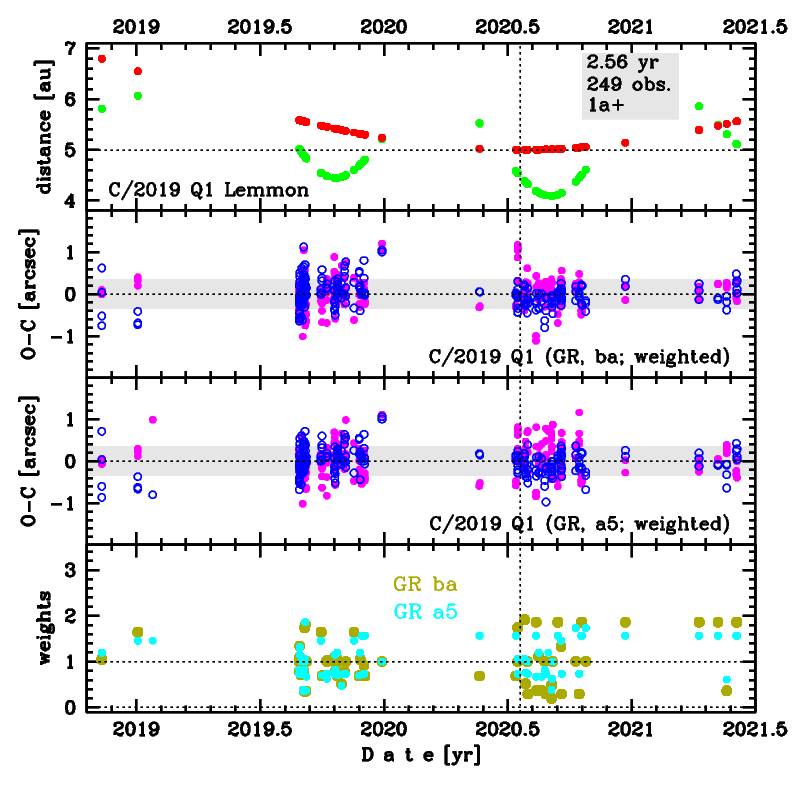C/2019 Q1 Lemmon
more info
Comet C/2019 Q1 was discovered on 28 August 2019, almost one year before its perihelion passage. Later two series of pre-discovery observations were found from 2 January 2019 and 10 November 2018. This comet was observed until 4 June 2021.
Comet had its closest approach to the Earth on 3 September 2020 (4.09 au); 1.5 month after its perihelion passage.
Solutions (GR and NG) given here are based on data span over 2.56 yr in a range of heliocentric distances: 6.80 au – 5.00 au (perihelion) – 5.56 au. Orbits based on pre-perihelion and post-perihelion data independently were also obtained.
This Oort spike comet suffers small planetary perturbations during its passage through the planetary system; however, they lead to escape this comet from the solar system on hyperbolic orbit (see future barycentric orbits).
Comet had its closest approach to the Earth on 3 September 2020 (4.09 au); 1.5 month after its perihelion passage.
Solutions (GR and NG) given here are based on data span over 2.56 yr in a range of heliocentric distances: 6.80 au – 5.00 au (perihelion) – 5.56 au. Orbits based on pre-perihelion and post-perihelion data independently were also obtained.
This Oort spike comet suffers small planetary perturbations during its passage through the planetary system; however, they lead to escape this comet from the solar system on hyperbolic orbit (see future barycentric orbits).
| solution description | ||
|---|---|---|
| number of observations | 247 | |
| data interval | 2018 11 10 – 2021 06 04 | |
| data type | perihelion within the observation arc (FULL) | |
| data arc selection | entire data set (STD) | |
| range of heliocentric distances | 6.8 au – 5.00 au (perihelion) – 5.56 au | |
| detectability of NG effects in the comet's motion | comet with determinable NG~orbit | |
| type of model of motion | GR - gravitational orbit | |
| data weighting | YES | |
| number of residuals | 480 | |
| RMS [arcseconds] | 0.35 | |
| orbit quality class | 1a+ | |
| next orbit statistics, both Galactic and stellar perturbations were taken into account | ||
|---|---|---|
| no. of returning VCs in the swarm | 0 | |
| no. of escaping VCs in the swarm | 5001 | |
| no. of hyperbolas among escaping VCs in the swarm | 5001 | * |
| next reciprocal semi-major axis [10-6 au-1] | -65.34 – -64.25 – -63.22 | |
| next perihelion distance [au] | 102.5 – 103 – 103.6 | |
| synchronous stop epoch [Myr] | 1.73 | S |
| percentage of VCs with qnext > 20 | 100 | |

Upper panel: Time distribution of positional observations with corresponding heliocentric (red curve) and geocentric (green curve) distance at which they were taken. The horizontal dotted line shows the perihelion distance for a given comet whereas vertical dotted line — the moment of perihelion passage.
Middle panel(s): O-C diagram for a given solution (sometimes in comparison to another solution available in CODE), where residuals in right ascension are shown using magenta dots and in declination by blue open circles.
Lowest panel: Relative weights for a given data set(s).
Middle panel(s): O-C diagram for a given solution (sometimes in comparison to another solution available in CODE), where residuals in right ascension are shown using magenta dots and in declination by blue open circles.
Lowest panel: Relative weights for a given data set(s).
| next_g orbit statistics, here only the Galactic tide has been included | ||
|---|---|---|
| no. of returning VCs in the swarm | 0 | |
| no. of escaping VCs in the swarm | 5001 | |
| no. of hyperbolas among escaping VCs in the swarm | 5001 | * |
| next reciprocal semi-major axis [10-6 au-1] | -70.52 – -69.40 – -68.33 | |
| next perihelion distance [au] | 16.56 – 16.69 – 16.83 | |
| synchronous stop epoch [Myr] | 1.73 | S |
| percentage of VCs with 10 < qnext < 20 | 100 | |